-
Professionals from the logistics field analyse the challenges and solutions for urban distribution of goods at the Distrifuture 2 event.
-
New technologies and public-public and public-private collaboration, key to the design of sustainable urban distribution of goods.
Logistop, the leading association in logistics innovation, brought together fifty experts in the logistics field in Alcobendas, Madrid, to participate in Distrifuture 2, towards sustainability in the digital era, the future of urban distribution of goods. The event, held on Thursday 25 April, became a forum for analysis in which professionals from both the public and private sectors debated the trends and challenges facing the urban distribution of goods.
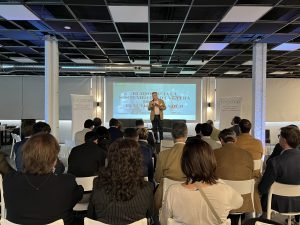
Currently, urban goods distribution has to deal with the problem of a lack of drivers, waiting times when purchasing vehicles and, additionally, the volume of business is growing steadily and still has a lot of room for growth.
Against this backdrop, Aristeo Rodríguez, Director de Acquisition Strategy & Go To Market at InPost, highlighted the growing relevance of the out-of-home model as a possible solution to mitigate the aforementioned challenges, underlining its potential to reduce emissions and traffic generated by transport vehicles which currently stands at 30% of the total. Furthermore, he emphasised the importance of educating the user to understand that home delivery should be considered as an added value, with an additional (not only economic) cost.
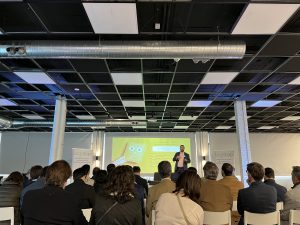
Sustainable and digital public strategy in urban distribution of goods
This was followed by the round table on Sustainable and digital public strategy in the urban distribution of goods, moderated by Tomás de la Vega, Managing Director at Logistop, in which different public administrations presented their strategies and tools that they are implementing in order to improve and develop more convenient, efficient and sustainable urban logistics.
Marc Iglesias, Head of Sustainable Mobility Management Service – Area of Mobility, Transport and Sustainability, AMB – Àrea Metropolitana de Barcelona, explained to those present the success, not only of the administration, but of the whole sector, of the development of a public application/tool in which everything related to the ZBEs of Barcelona and all the surrounding municipalities can be operated, seeing where all the zones are, their availability, their operability… It is an example of a simple tool that allows technology to be made available to the sector. In short, the aim is to establish the broadest possible tools, moving away from the idea that each small municipality has its own tool.
Along the same lines, Jone Argoitia, Director of the Mobility Department, Donostia/San Sebastián City Council, dhighlighted the complexity of the urban distribution of goods and of finding a balance between all the needs of the city and the sector, bringing order to a public space that is very limited, in addition to the complexity of fitting the entire logistics chain. “We have been demonising the urban distribution of goods sector for many years, but we have realised that there is a need to regulate this distribution properly”, she said.
As Jone Argoitia points out, the sector has responded well to the new technologies that are being implemented (including the sensorisation of some squares), as these implementations are of interest (and benefit) to all actors. She also concludes that greater sustainability in the urban distribution of goods will allow for a greater possibility of new distribution windows.
Likewise, data is fundamental when it comes to having real knowledge of what is happening and its collection and use is what allows cities to take that extra step towards becoming increasingly agile. In this sense, Javier Carvajal Naranjo, Head of the Mobility Planning Department at Madrid City Council, highlighted the importance and usefulness of putting all the data available to the administrations on their transparency portals so that it can be used by those actors who need it. This represents a level of progress that the public sector offers the city and which must be used and further developed. He also emphasised the importance of public-public collaboration (cities do not copy each other, they collaborate, he explained) and public-private collaboration, both of which are fundamental to continue making progress in everything related to the urban distribution of goods.
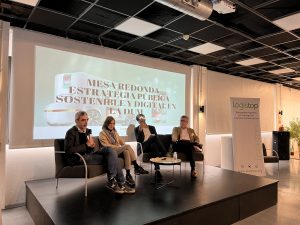
The road to the new urban distribution vehicles
This was followed by the round table discussion The road to new urban distribution vehicles – from the manufacturer’s point of view, moderated by Daniel Latorre, Head of Innovation for Urban Logistics at Logistop, and Deputy Managing Director at CITYlogin, in which the present and future of alternative energies and new vehicles were discussed.
Enrique Ruiz-Giménez, Head of Press at Mercedes-Benz Vans España, analysed the scenario in which the sector is currently moving, with a timeframe of between seven and eight years in which strategic decisions have to be taken with a view to the long term. In the specific case of their business strategy, he pointed out that they are opting for a combination of diesel vehicles for certain uses and 100% electric vehicles for others, as these, in practical terms, are not viable today for all uses due to their technological limitations. It is up to the end user to choose between the different options that manufacturers are offering.
Alasdair Leapman, European sales director for Applications BU at Plug Power, HYVIA, pointed out the confusion about the guidelines for the different technologies available, as well as a necessary improvement in the infrastructure available for the refuelling of these new technologies. “Right now, at least as far as we can see, there is no clear strategy. We need clearer guidelines and more infrastructures”, he stressed.
José María Gómez Márquez, CEO at SCOOBIC, emphasised the importance of manufacturing in Spain and the rest of Europe “so as not to depend on Asia, to generate employment in our cities and countries, and to have our own technology and be able to export it”.
As has been discussed throughout the day, in this ecosystem of continuous and constant change, it is necessary to bring order to the coexistence between pedestrians and urban mobility. With regard to existing or forthcoming regulations, Jordi Escruela, Head of Business Development at MOOEVO, pointed out that regulation has to adopt a facilitating role, as it is thanks to this regulation that the change that is already taking place is being forged. “From now on we are going to see more aggressive actions from the regulator that will affect us. We are coming from a time of great effort to change the morphology of cities and make them sustainable. The new regulations to be implemented soon will double that demand”, he analysed.
To conclude, they all concluded that there is no single vehicle or technology that can cover all needs, but there are general features such as those mentioned by José María Gómez: “vehicles must be small, easy to park and with zero emissions. For example, in the centre of a city with micro-logistics vehicles, the number of deliveries multiplies up to 20-30% per hour”.
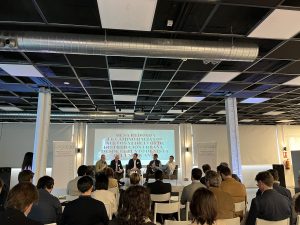
Information Systems for delivery efficiency
To end the day, Jorge Ruiz Magaña, Director of the Engineering and Software Development Unit at Solusoft, presented a series of use cases in which he highlighted the importance of adapting the last mile to each business and specific need, being able to carry out simulations that will allow for greater efficiency and reduce the margin of error. “The important thing is to take advantage of digitalisation for each of the stages that occur in the supply chain”, he concluded.
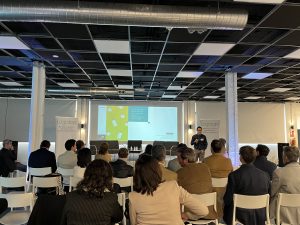
In summary, during the event Distrifuture 2, towards sustainability in the digital era, the future of urban distribution of goods organised by Logistop, it has been highlighted that collaboration between the public and private sectors is essential to address the challenges of urban distribution of goods. From the implementation of technological tools to the promotion of more sustainable logistics, there is a consensus on the need for concrete and coordinated measures to ensure efficient and sustainable urban logistics. Furthermore, the conference highlighted the importance of adapting to a constantly changing environment, taking advantage of digitalisation and innovation to improve the last mile and reduce environmental impact with a proactive and collaborative approach.
About Logistop
At Logistop we transform the supply chain through innovation, helping industry and companies to become more efficient and sustainable.
We are a multidisciplinary and inter-territorial working space in the logistics innovation arena formed by all the actors involved in the supply chain, as well as universities, technology centres, associations and specialised consultancy firms.
One of Logistop’s main objectives is:
- To promote the need for innovation among companies involved in the logistics sector;
- To promote innovation projects;
- To communicate the real needs of the sector at an institutional level.
